Design and Optimization of 3D-Printed Variable Cross-Section I-Beams Reinforced with Continuous and Short Fibers
Abstract
:1. Introduction
2. Materials and Methods
2.1. 3D-Printing Process
2.2. Three-Point Bending Testing
2.3. Design of Configuration
2.4. Optimization of Configuration
2.4.1. Finite Element Analysis
2.4.2. Indexes and Objective Functions
2.4.3. Multi-Objective Optimization Analysis
2.5. Geometry Parameters of Configuration
3. Results and Discussion
3.1. Flexural Properties of Different Configurations
3.2. Flexural Properties of Different Reinforcements
3.3. Flexural Properties of Different Matrices
3.4. Material Selection
4. Conclusions
- The flexural properties of 3D-printed I-beams were significantly improved via structural design and multi-objective optimization, which were based on the equal-strength philosophy and the NSGA-II algorithm, respectively. Design and optimization reduced the mass of I-beams made of SCFs-reinforced PAs by 24.10% and 30.63%, respectively. The structures also exhibited a 14.46% and 30.05% increase in the stiffness-to-mass ratio and a 7.83% and 40.59% increase in the load-to-mass ratio, respectively. The design and optimization method proved to be effective for 3D-printed I-beams.
- Compared with pure PA structures, although the CCFs-reinforced PA I-beam exhibited a substantial improvement (2926%) in its stiffness-to-mass ratio, the addition of SCFs also increased the stiffness-to-mass ratio and the load-to-mass ratio by 1070% and 344.4%, respectively. Considering that the price of CCFs-reinforced PAs (USD 337.5) is much higher than SCFs-reinforced PAs (USD 5.5), SCFs-reinforced PAs have the potential to serve as an economical substitute for CCFs-reinforced PAs. The 3D-prined I-beam of the O-type configuration produced by SCF-reinforced PAs had a relatively high stiffness-to-mass ratio (4.45 N·mm−1g−1) and load-to-mass ratio (30.89 N·g−1), while the corresponding PA structure had a stiffness-to-mass ratio of 0.38 N·mm−1g−1 and a load-to-mass ratio of 6.95 N·g−1.
- Compared with PLAs (elongation at break of 29.92%), PAs (elongation at break of 196%) are a better choice of matrix to demonstrate the adverse effects of reinforcements. The addition of reinforcements, such as SGFs, SCFs, or CCFs, improves the mechanical properties of PA composite I-beams to a great extent. However, in PLA resin, the incorporation of SGFs and SCFs increased the stiffness-to-mass ratio but caused premature structural failure and reduced the load-to-mass ratio. Although the addition of SCFs increased the stiffness-to-mass ratio of PLA I-beams by 13.64%, the load-to-mass ratio was reduced by 10.63%.
Author Contributions
Funding
Institutional Review Board Statement
Data Availability Statement
Conflicts of Interest
References
- Hsissou, R.; Seghiri, R.; Benzekri, Z.; Hilali, M.; Rafik, M.; Elharfi, A. Polymer composite materials A comprehensive review. Compos. Struct. 2021, 262, 113640. [Google Scholar] [CrossRef]
- Zhang, J.; Lin, G.; Vaidya, U.; Wang, H. Past, present and future prospective of global carbon fibre composite developments and applications. Compos. Part B Eng. 2023, 250, 110463. [Google Scholar] [CrossRef]
- Gemi, L.; Madenci, E.; Özkılıç, Y.O.; Yazman, Ş.; Safonov, A. Effect of fiber wrapping on bending behavior of reinforced concrete filled pultruded GFRP composite hybrid beams. Polymers 2022, 14, 3740. [Google Scholar] [CrossRef]
- Zhao, F.; Bao, H. Shape sensing approach for composite and sandwich beam with generic cross-sections: Application to fiber-reinforced polymer composite airfoil. Aerosp. Sci. Technol. 2023, 138, 108314. [Google Scholar] [CrossRef]
- Li, J.; Wang, J.; Yu, L.; Liu, W.; Zhang, L. Study on failure mechanisms of composite box beams on wind turbine blades under extreme combined loading. Mech. Adv. Mater. Struct. 2022, 29, 2176–2185. [Google Scholar] [CrossRef]
- Li, Y.; Xiao, Y.; Yu, L.; Ji, K.; Li, D. A review on the tooling technologies for composites manufacturing of aerospace structures: Materials, structures and processes. Compos. Part A Appl. Sci. Manuf. 2022, 154, 106762. [Google Scholar] [CrossRef]
- Chen, J.; Liu, X.; Tian, Y.; Zhu, W.; Yan, C.; Shi, Y.; Kong, L.B.; Qi, H.J.; Zhou, K. 3D-Printed anisotropic polymer materials for functional applications. Adv. Mater. 2022, 34, 2102877. [Google Scholar] [CrossRef]
- Wang, Y.; Li, L.; Hofmann, D.; Andrade, J.E.; Daraio, C. Structured fabrics with tunable mechanical properties. Nature 2021, 596, 238–243. [Google Scholar] [CrossRef]
- Wang, K.; Wang, D.; Liu, Y.; Gao, H.; Yang, C.; Peng, Y. Path Planning and Bending Behaviors of 3D Printed Continuous Carbon Fiber Reinforced Polymer Honeycomb Structures. Polymers 2023, 15, 4485. [Google Scholar] [CrossRef] [PubMed]
- Tian, Y.; Chen, K.; Zheng, H.; Kripalani, D.R.; Zeng, Z.; Jarlöv, A.; Chen, J.; Bai, L.; Ong, A.; Du, H.; et al. Additively Manufactured Dual-Faced Structured Fabric for Shape-Adaptive Protection. Adv. Sci. 2023, 10, 2301567. [Google Scholar] [CrossRef] [PubMed]
- Zhang, D.; Tian, X.; Zhou, Y.; Wang, Q.; Yan, W.; Zia, A.A.; Wu, L.; Li, D. Spatial 3D Printing of Continuous Fiber-Reinforced Composite Multilayer Truss Structures with Controllable Structural Performance. Polymers 2023, 15, 4333. [Google Scholar] [CrossRef]
- Parandoush, P.; Lin, D. A review on additive manufacturing of polymer-fiber composites. Compos. Struct. 2017, 182, 36–53. [Google Scholar] [CrossRef]
- Zhang, X.; Zheng, X.; Song, L.; Tian, Y.; Zhang, D.; Yan, L. Compressive properties and failure mechanisms of 3D-printed continuous carbon fiber-reinforced auxetic structures. Compos. Commun. 2023, 43, 101744. [Google Scholar] [CrossRef]
- Li, N.; Li, Y.; Liu, S. Rapid prototyping of continuous carbon fiber reinforced polylactic acid composites by 3D printing. J. Mater. Process. Technol. 2016, 238, 218–225. [Google Scholar] [CrossRef]
- Gupta, A.; Fidan, I.; Hasanov, S.; Nasirov, A. Processing, mechanical characterization, and micrography of 3D-printed short carbon fiber reinforced polycarbonate polymer matrix composite material. Int. J. Adv. Manuf. Technol. 2020, 107, 3185–3205. [Google Scholar] [CrossRef]
- HR, M.; Benal, M.G.M.; GS, P.; Tambrallimath, V.; Ramaiah, K.; Khan, T.Y.; Bhutto, J.K.; Ali, M.A. Effect of Short Glass Fiber Addition on Flexural and Impact Behavior of 3D Printed Polymer Composites. ACS Omega 2023, 8, 9212–9220. [Google Scholar] [CrossRef] [PubMed]
- Zeng, C.; Liu, L.; Bian, W.; Leng, J.; Liu, Y. Bending performance and failure behavior of 3D printed continuous fiber reinforced composite corrugated sandwich structures with shape memory capability. Compos. Struct. 2021, 262, 113626. [Google Scholar] [CrossRef]
- Wu, S.; Shan, Z.; Chen, K.; Wang, S.; Zou, A.; Sun, Q. Bending properties and failure behavior of 3D printed fiber reinforced resin T-beam. Polym. Compos. 2022, 43, 4556–4568. [Google Scholar] [CrossRef]
- Long, S.; Zong, H.; Liu, T.; Yao, X. Soft impact behavior of composite I-beams. Compos. Struct. 2023, 304, 116477. [Google Scholar] [CrossRef]
- Chen, S.; Wei, Y.; Zhao, K.; Dong, F.; Huang, L. Experimental investigation on the flexural behavior of laminated bamboo-timber I-beams. J. Build. Eng. 2022, 46, 103651. [Google Scholar] [CrossRef]
- Wang, J.; Zhang, L.; Li, J.; Huang, X.; Li, C. Investigation on torsional performance of wind turbine blades under pure torsion through subcomponent test. Compos. Struct. 2023, 304, 116466. [Google Scholar] [CrossRef]
- Ibrahim, T.H.; Allawi, A.A.; El-Zohairy, A. Experimental and FE analysis of composite RC beams with encased pultruded GFRP I-beam under static loads. Adv. Struct. Eng. 2023, 26, 516–532. [Google Scholar] [CrossRef]
- Ruzuqi, R. Tensile strength analysis of polymer composite materials fiber reinforced in the fiber boat application. J. Res. Opin. 2020, 7, 2763–2769. [Google Scholar]
- Craig, R.R., Jr.; Taleff, E.M. Mechanics of Materials; John Wiley & Sons: Hoboken, NJ, USA, 2020. [Google Scholar]
- Polilov, A.N.; Tatus, N.A.; Tian, X. Analyzing the correctness of equal strength composite profiled beam bending problems. J. Appl. Mech. Tech. Phys. 2019, 60, 144–155. [Google Scholar] [CrossRef]
- Um, H.J.; Lee, J.S.; Shin, J.H.; Kim, H.S. 3D printed continuous carbon fiber reinforced thermoplastic composite sandwich structure with corrugated core for high stiffness/load capability. Compos. Struct. 2022, 291, 115590. [Google Scholar] [CrossRef]
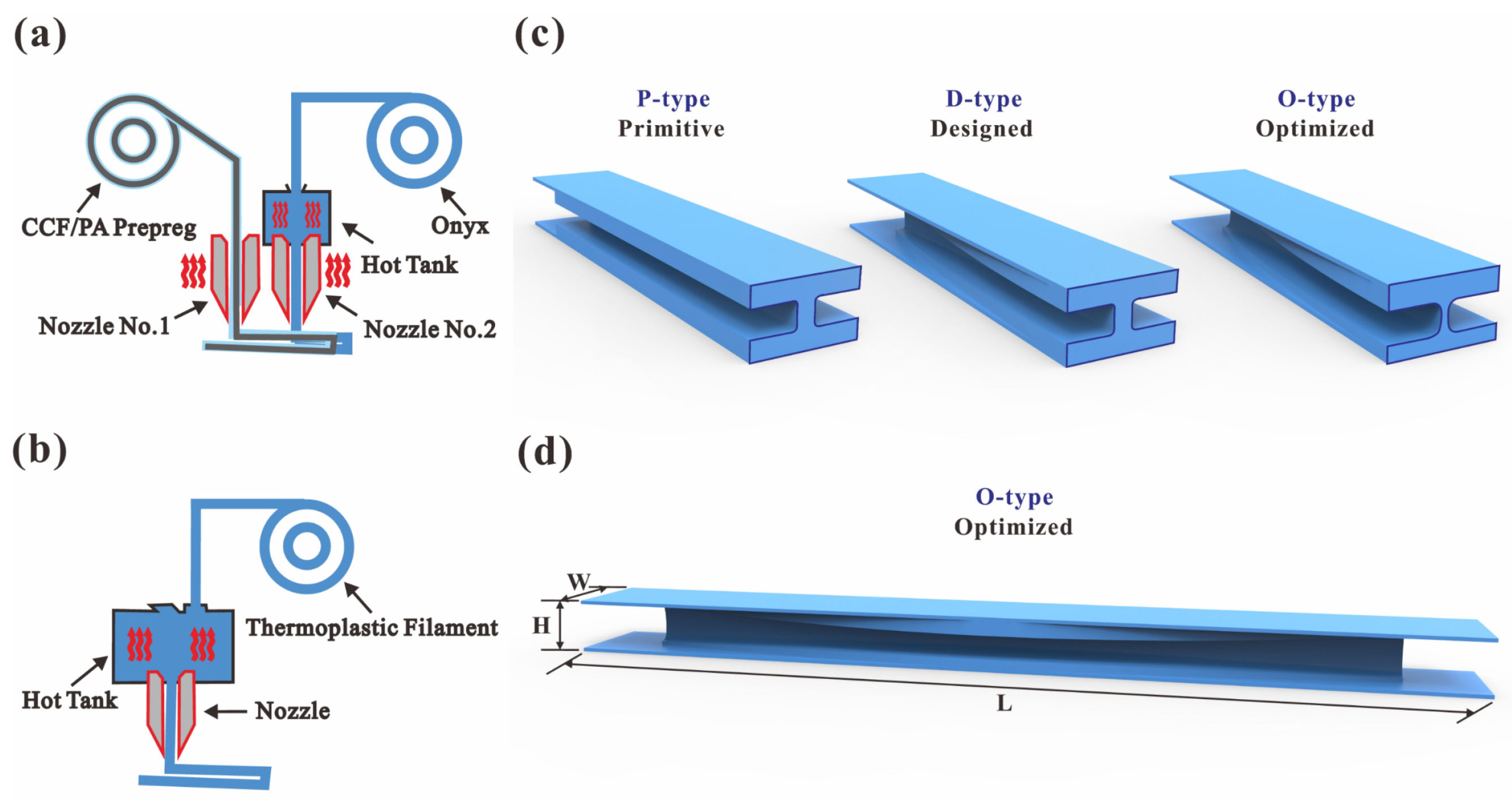



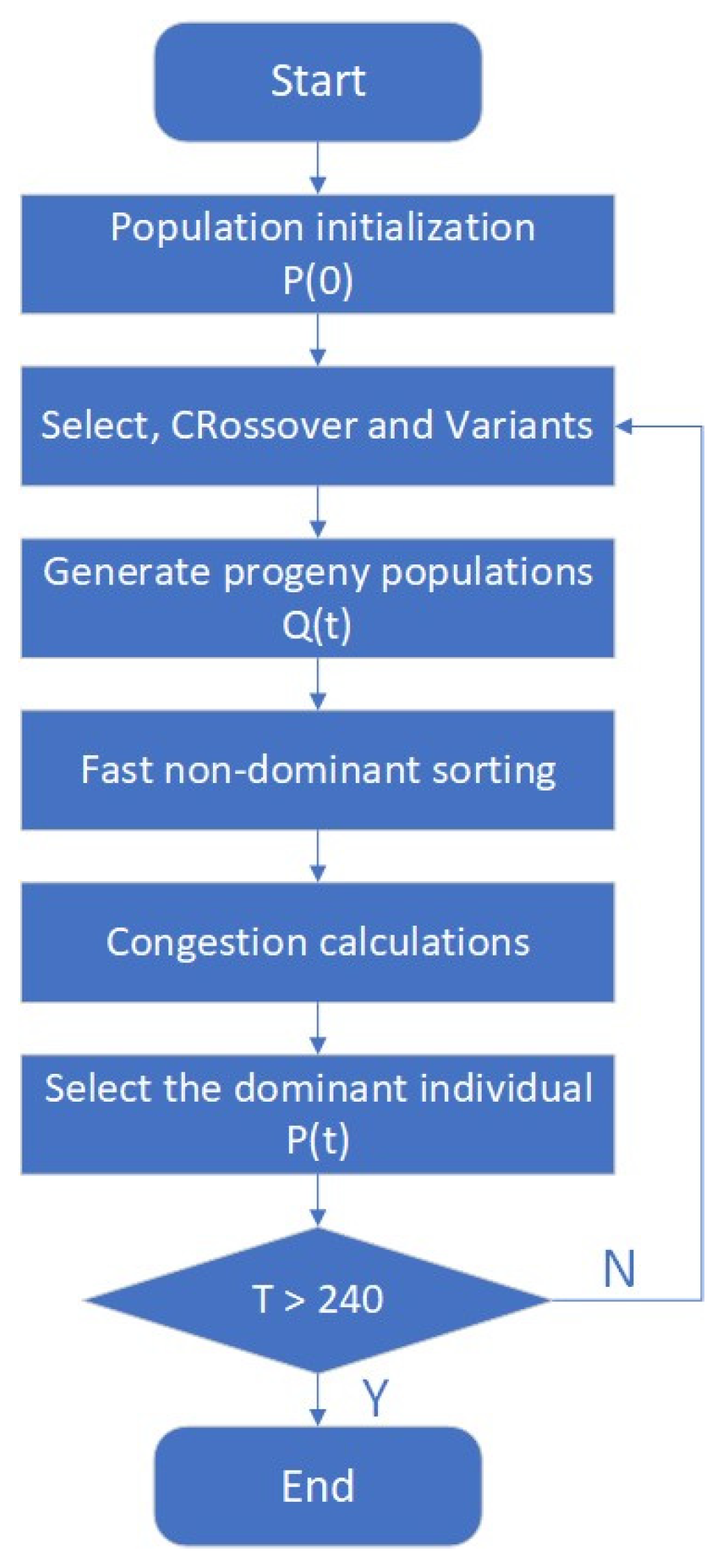
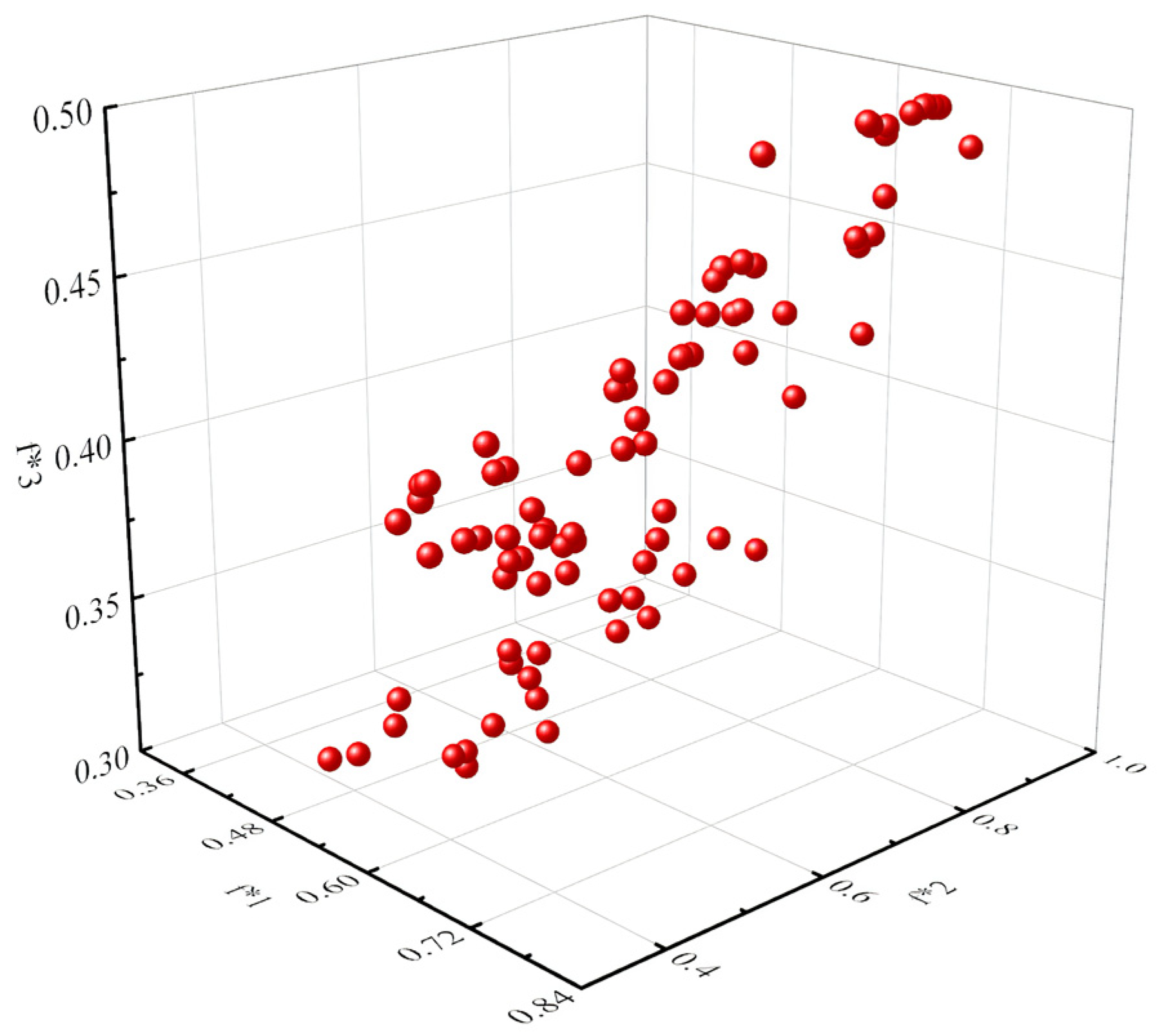
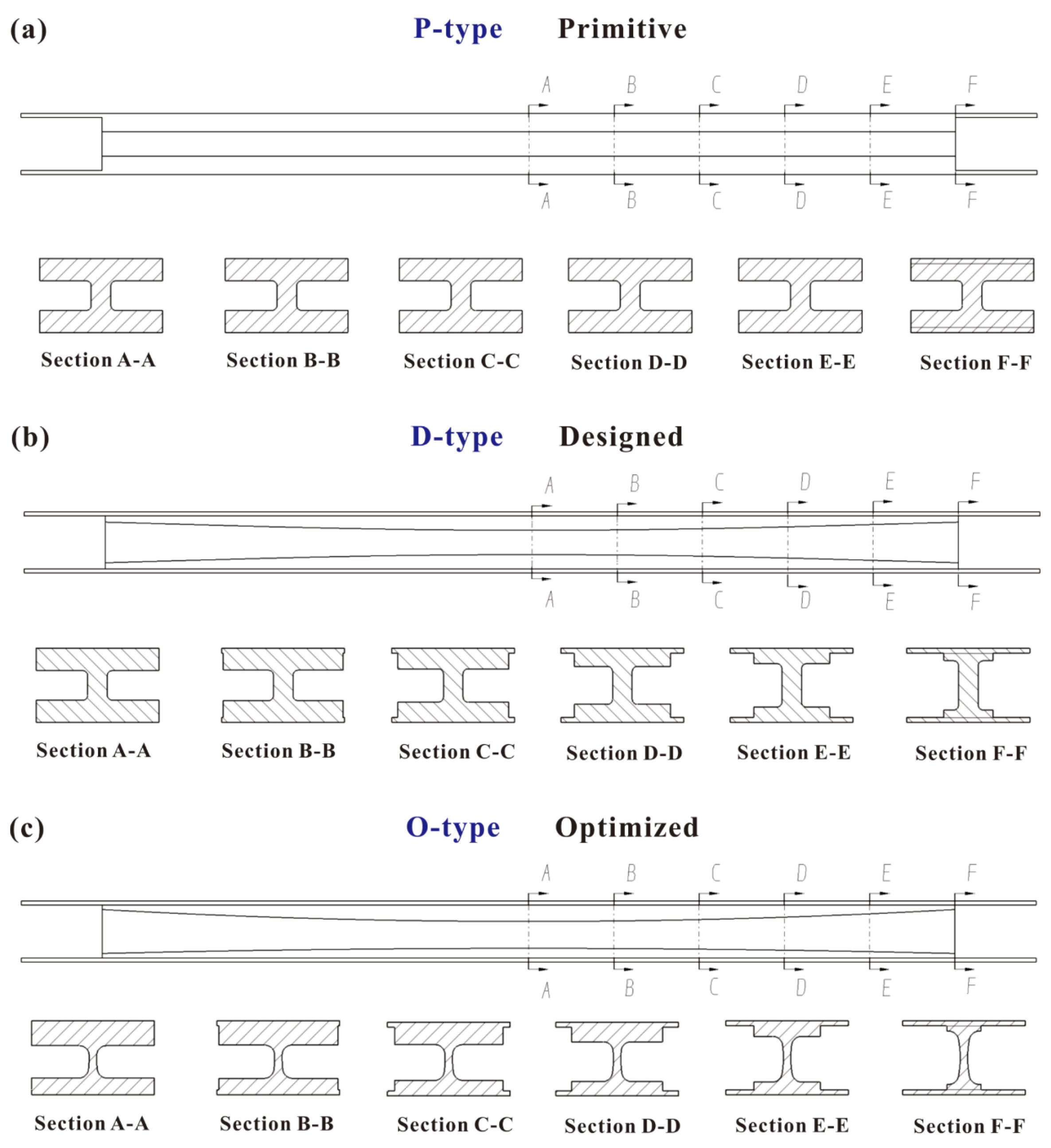
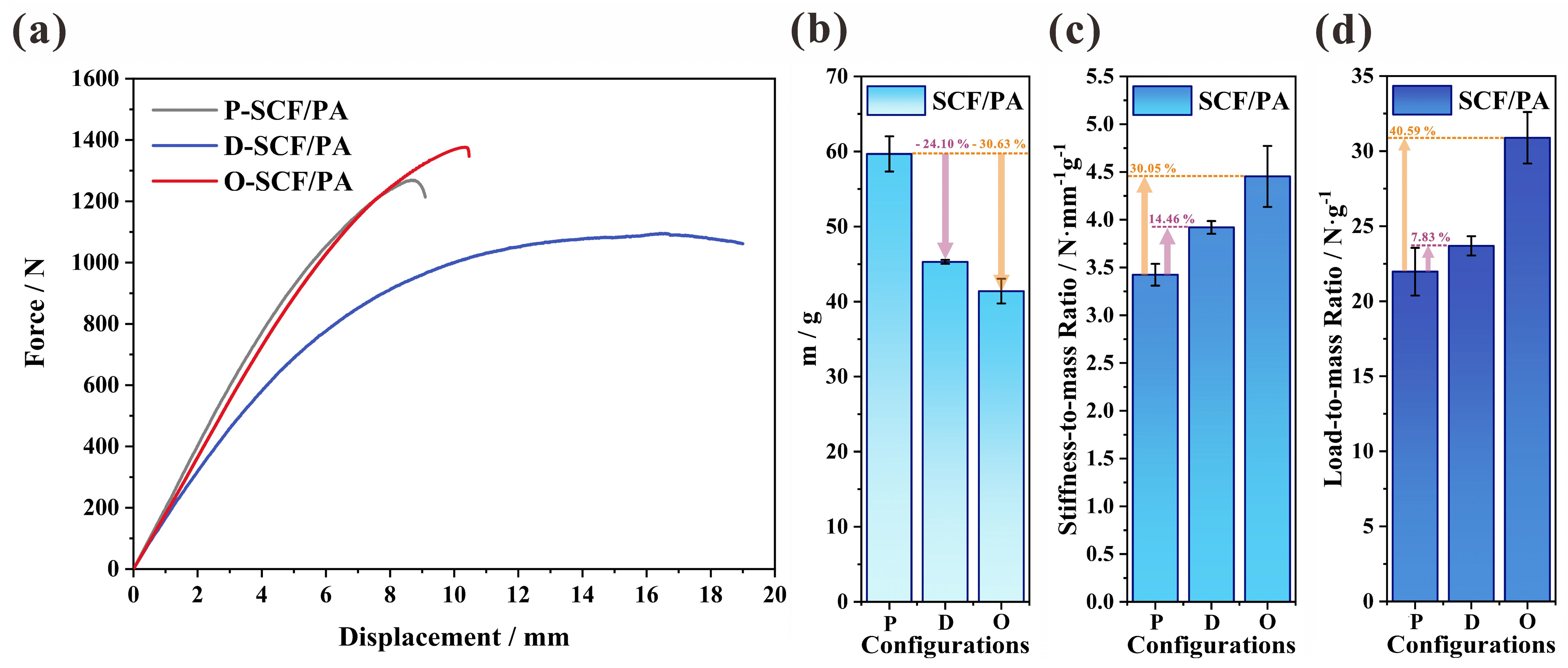
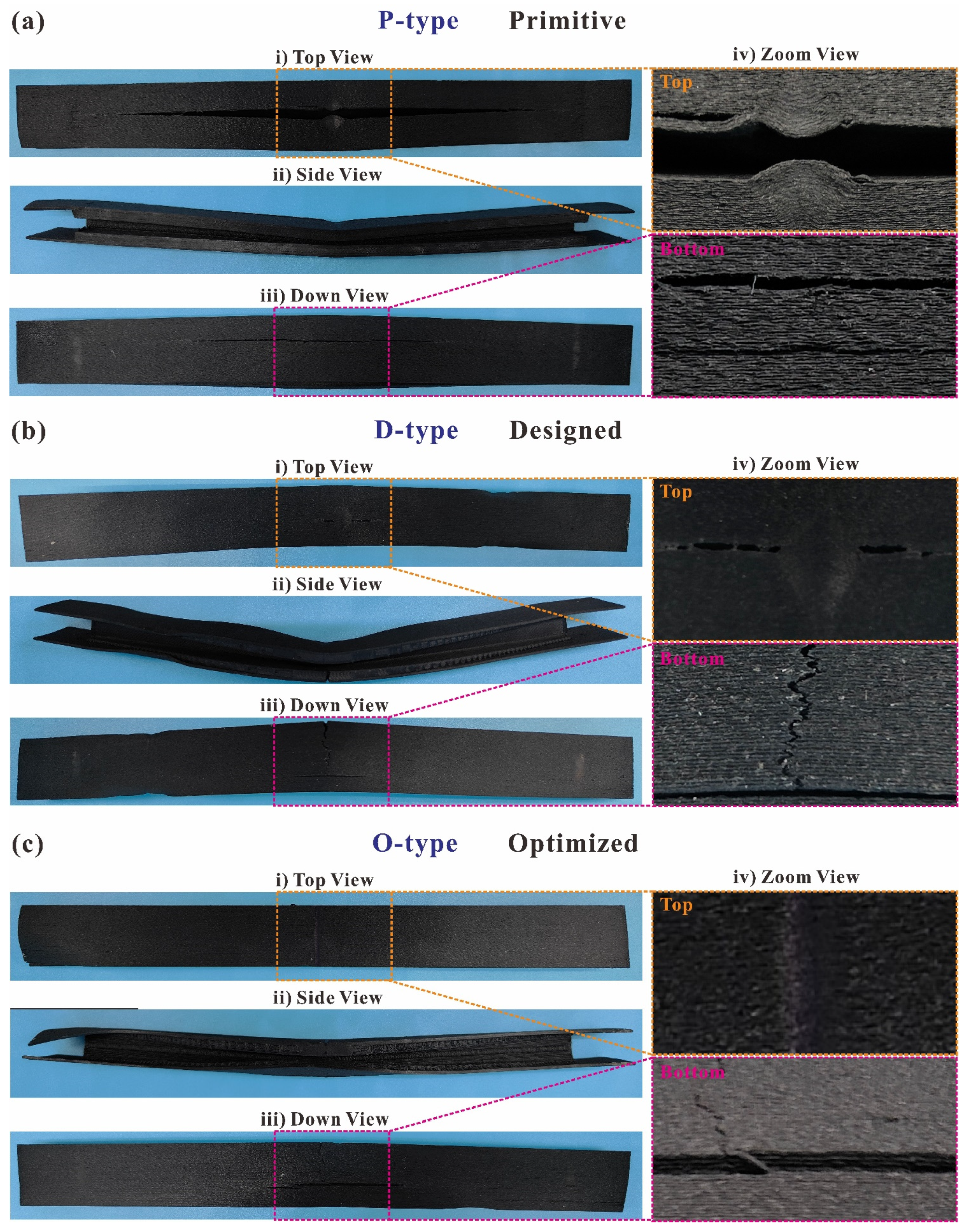
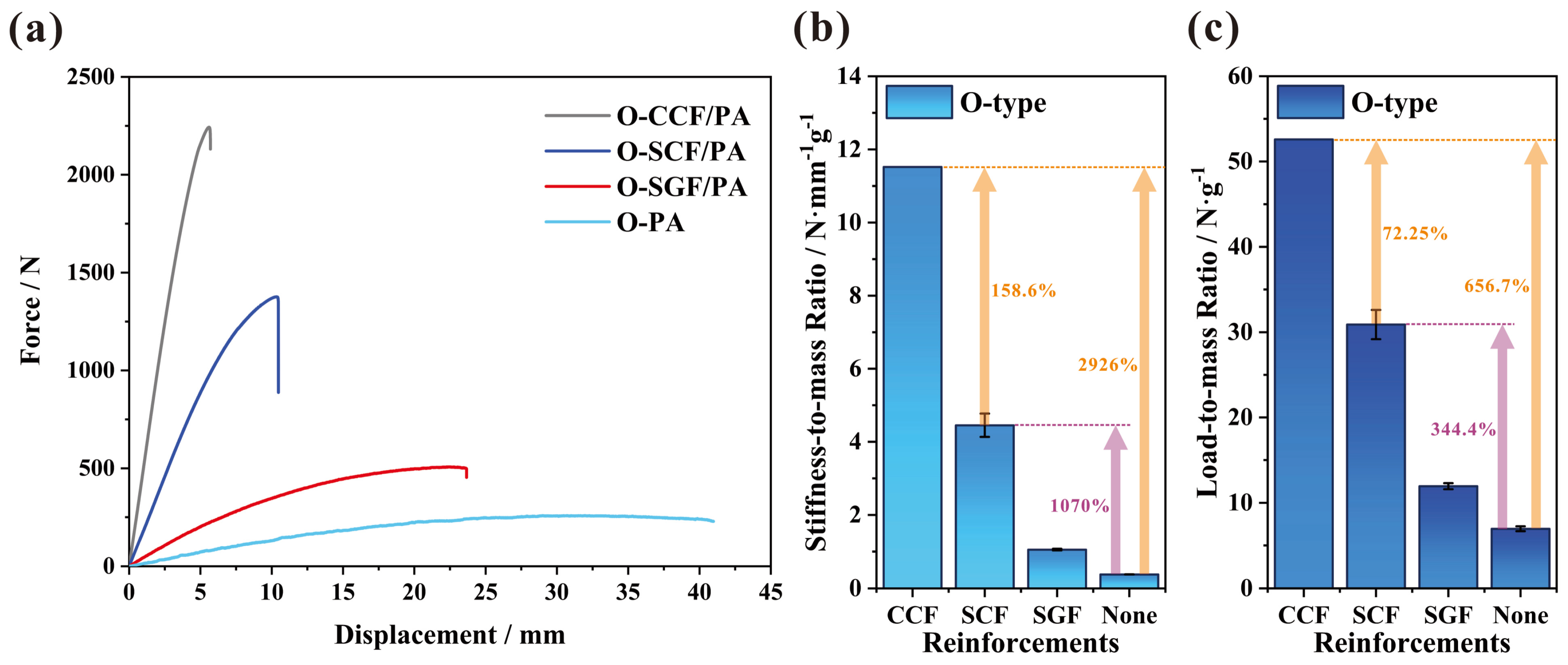

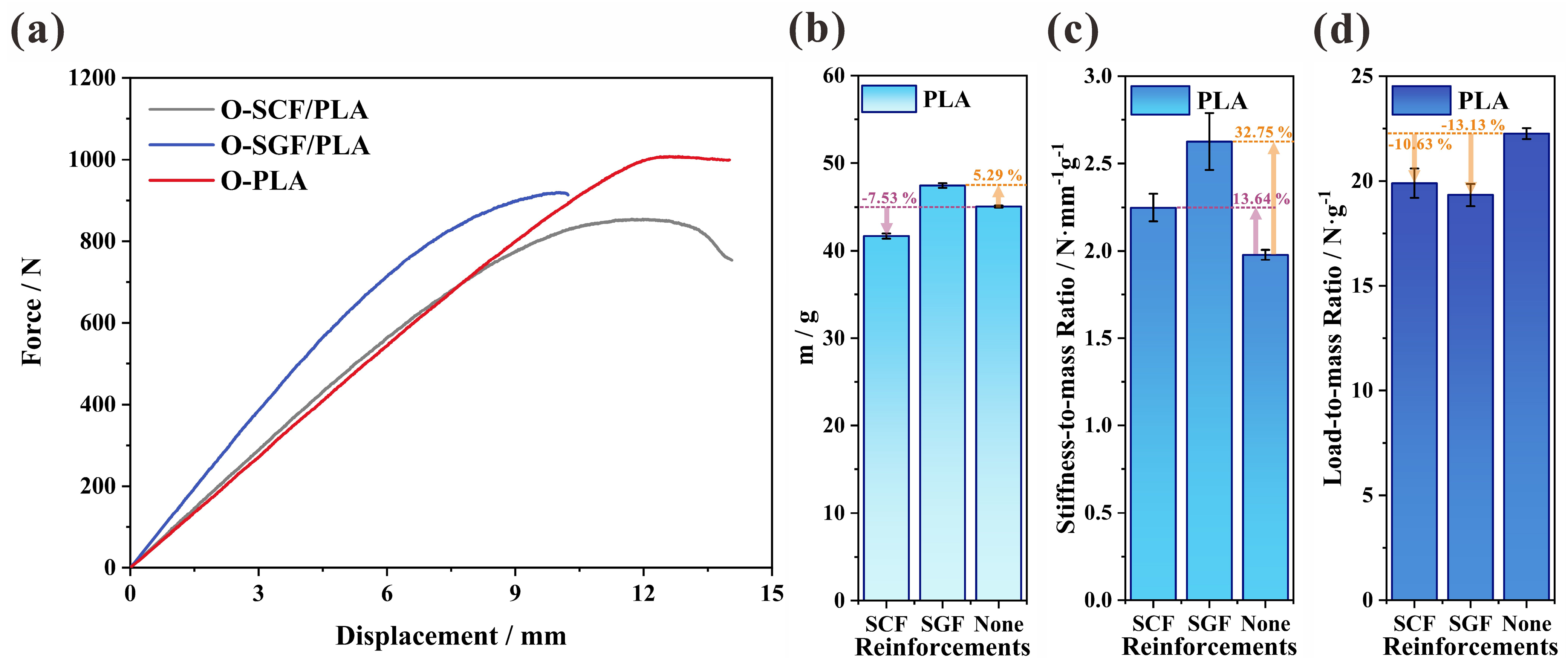
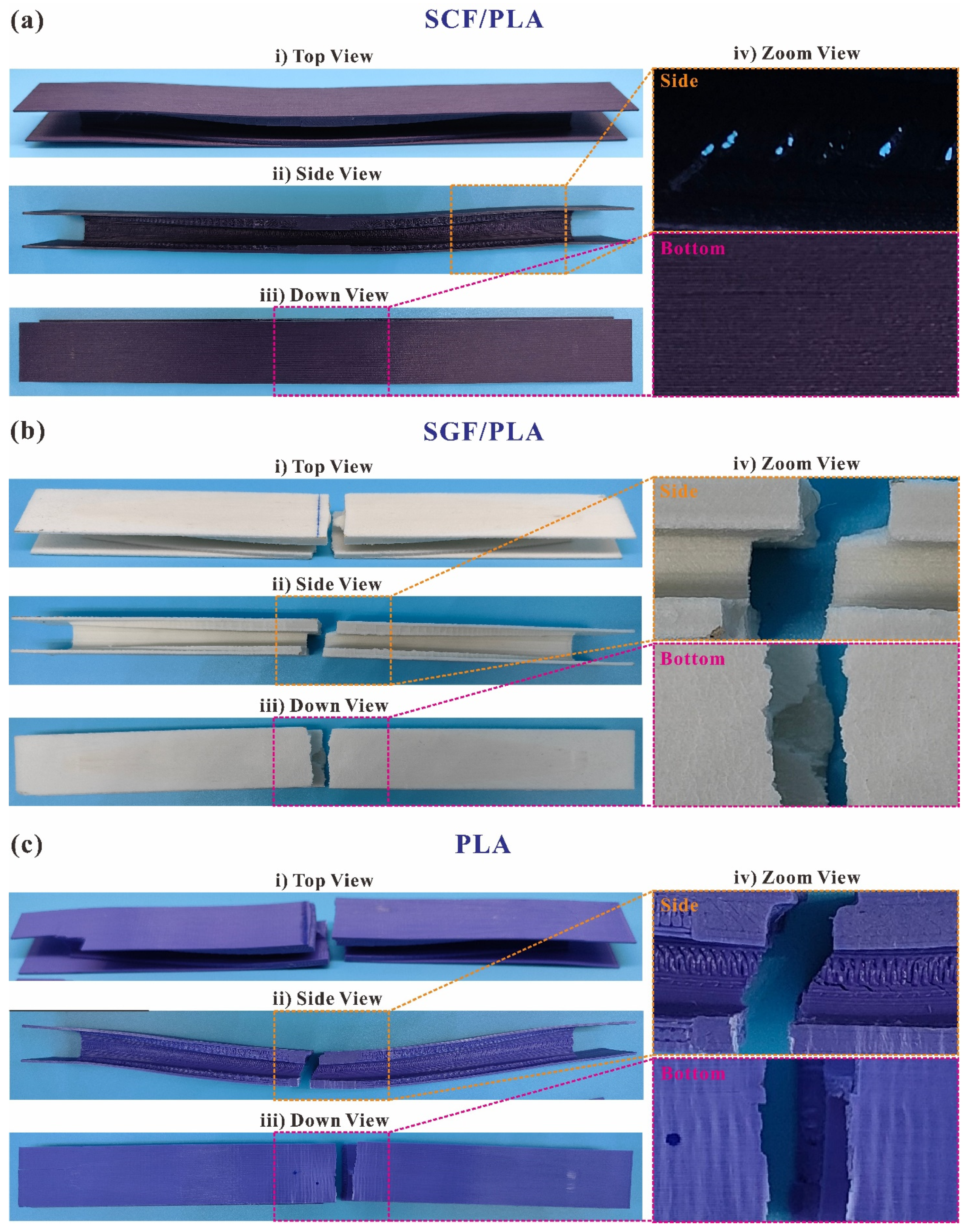
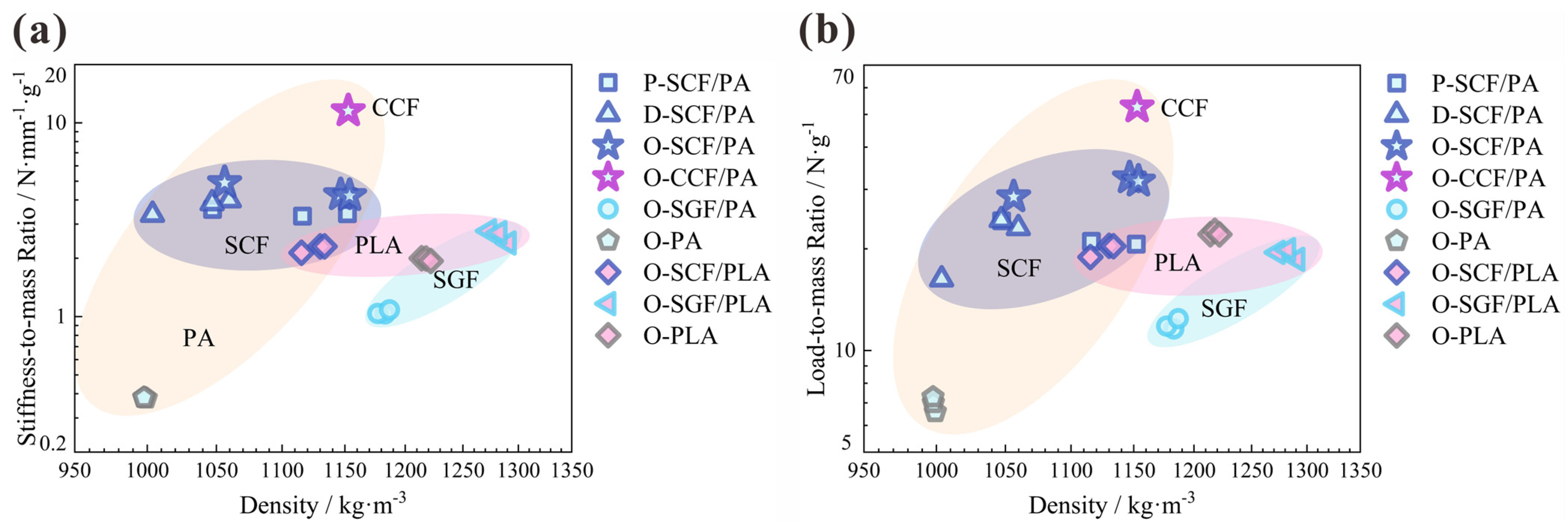
| Suppliers | Type | Tensile Strength/MPa | Modulus/GPa | Elongation at Break/% | Density/g·cm−3 |
|---|---|---|---|---|---|
| Markforged | PA-CCF | 800 | 51 | 1.5 | 1.4 |
| Onyx | 35.71 | 3.59 | 4 | 1.2 | |
| eSUN | ePAHT-CF | 173.37 | 5.61 | 8.93 | 1.4 |
| ePA-GF | 76.93 | 1.72 | 20.07 | 1.35 | |
| ePA | 57 | 1.5 | 196 | 1.12 | |
| ePLA-CF | 28 | 3.55 | 4.27 | 1.21 | |
| ePLA-GF | 59.27 | 4.41 | 7.99 | 1.31 | |
| ePLA-Lite | 61.34 | 3.82 | 29.92 | 1.23 |
| Type | Layer Thickness/mm | Nozzle Temperature/°C | Hatch Space/mm | Printing Speed/mm·s−1 |
|---|---|---|---|---|
| PA-CCF | 0.125 | 275 | 1 | 15 |
| Onyx | 0.2 | 260 | 0.5 | 15 |
| ePAHT-CF | 0.2 | 240 | 0.5 | 50 |
| ePA-GF | 0.2 | 240 | 0.5 | 50 |
| ePA | 0.2 | 240 | 0.5 | 50 |
| ePLA-CF | 0.2 | 210 | 0.5 | 50 |
| ePLA-GF | 0.2 | 210 | 0.5 | 50 |
| ePLA-Lite | 0.2 | 210 | 0.5 | 50 |
| Type | Section Lable | Wb/mm | Ww/mm | Hu/mm | Hb/mm |
|---|---|---|---|---|---|
| P | A-A | 25 | 4 | 4.5 | 4.5 |
| B-B | 25 | 4 | 4.5 | 4.5 | |
| C-C | 25 | 4 | 4.5 | 4.5 | |
| D-D | 25 | 4 | 4.5 | 4.5 | |
| E-E | 25 | 4 | 4.5 | 4.5 | |
| F-F | 25 | 4 | 4.5 | 4.5 | |
| D | A-A | 25 | 4 | 4.5 | 4.5 |
| B-B | 24.4 | 4 | 4.41 | 4.41 | |
| C-C | 22.6 | 4 | 4.12 | 4.12 | |
| D-D | 19.6 | 4 | 3.66 | 3.66 | |
| E-E | 15.4 | 4 | 3.09 | 3.09 | |
| F-F | 10 | 4 | 2.5 | 2.5 | |
| O | A-A | 25 | 1.5 | 5.04 | 3.36 |
| B-B | 24.28 | 1.5 | 4.92 | 3.31 | |
| C-C | 22.12 | 1.5 | 4.57 | 3.16 | |
| D-D | 18.52 | 1.5 | 3.98 | 2.91 | |
| E-E | 13.48 | 1.5 | 3.16 | 2.55 | |
| F-F | 7 | 1.5 | 2.1 | 2.1 |
| Configuration | Materials | Span/mm | H/mm | Stiffness-to-Mass Ratio/mm | Load-to-Mass Ratio/mm | Reference |
|---|---|---|---|---|---|---|
| O-type | CCF/PA | 200 | 15 | 11.52 | 52.59 | This work |
| O-type | SCF/PA | 200 | 15 | 4.45 | 30.89 | |
| D-type | SCF/PA | 200 | 15 | 3.92 | 23.69 | |
| Corrugated core | CCF/PA | 141 | 23.2 | 28.49 | 57.98 | [26] |
| SCF/PA | 141 | 23.2 | 10.6 | 23.44 | ||
| Diamond core | CCF/PA | 80 | 10 | 627.7 | 68.33 | [9] |
Disclaimer/Publisher’s Note: The statements, opinions and data contained in all publications are solely those of the individual author(s) and contributor(s) and not of MDPI and/or the editor(s). MDPI and/or the editor(s) disclaim responsibility for any injury to people or property resulting from any ideas, methods, instructions or products referred to in the content. |
© 2024 by the authors. Licensee MDPI, Basel, Switzerland. This article is an open access article distributed under the terms and conditions of the Creative Commons Attribution (CC BY) license (https://creativecommons.org/licenses/by/4.0/).
Share and Cite
Zhang, X.; Sun, P.; Zhang, Y.; Wang, F.; Tu, Y.; Ma, Y.; Zhang, C. Design and Optimization of 3D-Printed Variable Cross-Section I-Beams Reinforced with Continuous and Short Fibers. Polymers 2024, 16, 684. https://doi.org/10.3390/polym16050684
Zhang X, Sun P, Zhang Y, Wang F, Tu Y, Ma Y, Zhang C. Design and Optimization of 3D-Printed Variable Cross-Section I-Beams Reinforced with Continuous and Short Fibers. Polymers. 2024; 16(5):684. https://doi.org/10.3390/polym16050684
Chicago/Turabian StyleZhang, Xin, Peijie Sun, Yu Zhang, Fei Wang, Yun Tu, Yunsheng Ma, and Chun Zhang. 2024. "Design and Optimization of 3D-Printed Variable Cross-Section I-Beams Reinforced with Continuous and Short Fibers" Polymers 16, no. 5: 684. https://doi.org/10.3390/polym16050684






